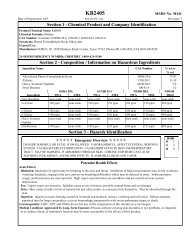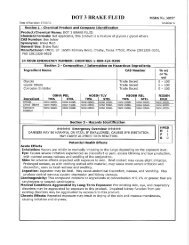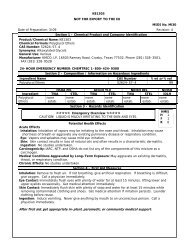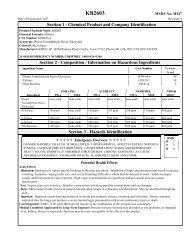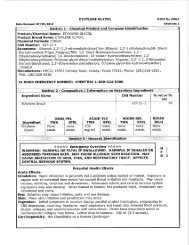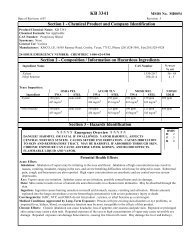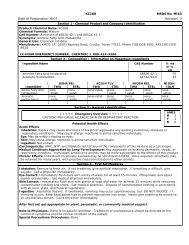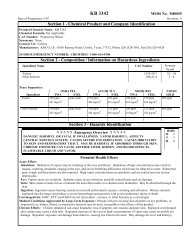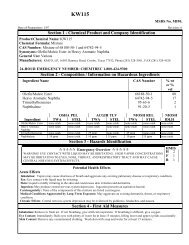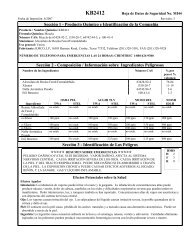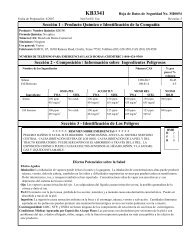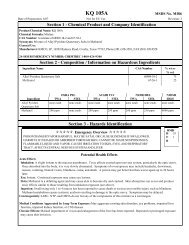KT 1261C - KMCO
KT 1261C - KMCO
KT 1261C - KMCO
Create successful ePaper yourself
Turn your PDF publications into a flip-book with our unique Google optimized e-Paper software.
<strong>KT</strong> <strong>1261C</strong><br />
MSDS No. MI138<br />
Date of Preparation: 7/06 Revision: 1<br />
Section 1 - Chemical Product and Company Identification<br />
Product/Chemical Name: <strong>KT</strong> <strong>1261C</strong><br />
Chemical Formula: Mixture<br />
CAS Number: Mixture<br />
Other Designations: ALKYLARYLSULFONIC ACID IN AROMATIC HYDROCARBON<br />
General Use: VARIOUS<br />
Manufacturer: <strong>KMCO</strong>,LP, 16503 Ra msey Road, Crosby, Texas, 77532, Phone (281) 328-3501, Fax (281) 328-9528<br />
24-HOUR EMERGENCY NUMBER: CHEMTREC 1-800-424-9300<br />
Section 2 - Composition / Information on Hazardous Ingredients<br />
Ingredient Name CAS Number % wt or<br />
% vol<br />
Light Aromatic Solvent Naphtha 64742-95-6 35 – 70<br />
Alkylarylsulfonic Acid, Amine Salt Proprietary 10 – 50<br />
Alkylarylsulfonic Acid Proprietary 10 – 25<br />
Alkylarylhydrocarbon Proprietary 5 – 15<br />
1,2,4-Trimethylbenzene 95-63-6 5 - 30<br />
Amine Salt of Sulfuric Acid 0 –8<br />
Cumene 98-82-8 Trace<br />
Xylenes 1330-20-7 Trace<br />
Ethylbenzene 100-41-4 Trace<br />
Toluene 108-88-3 Trace<br />
Benzene 71-43-2 Trace<br />
OSHA PEL ACGIH TLV NIOSH REL NIOSH<br />
Ingredient TWA STEL TWA STEL TWA STEL IDLH<br />
Light Aromatic 300 ppm 400 ppm 300 ppm None estab. None estab. None estab. None estab.<br />
Solvent Naphtha<br />
Alkylarylsulfonic None estab. None estab. None estab. None estab. None estab. None estab. None estab.<br />
Acid, Amine Salt<br />
Alkylarylsulfonic None estab. None estab. None estab. None estab. None estab. None estab. None estab.<br />
Acid<br />
Alkylarylhydrocarbo None estab. None estab. None estab. None estab. None estab. None estab. None estab.<br />
n<br />
1,2,4-<br />
None estab. None estab. 25 ppm None estab. 25 ppm None estab. None estab.<br />
Trimethylbenzene<br />
Amine Salt of None estab. None estab. None estab. None estab. None estab. None estab. None estab.<br />
Sulfuric Acid<br />
Cumene 50 ppm None estab. 50 ppm None estab. 50 ppm None estab. 900 ppm<br />
Xylenes 100 ppm None estab. 100 ppm 150 ppm 100 ppm 150 ppm None estab.<br />
Ethylbenzene 100 ppm None estab. 100 ppm 125 ppm 100 ppm 125 ppm 500 ppm<br />
Toluene 200 ppm 300 ppm 50 ppm None estab. 100 ppm 150 ppm 500 ppm<br />
Benzene 1 ppm 5 ppm 0.5 ppm 2.5 ppm 0.1 ppm 1 ppm 500 ppm<br />
Section 3 - Hazards Identification<br />
Emergency Overview <br />
DANGER!<br />
MAY BE CORROSIVE TO THE SKIN, EYES AND RESPIRATORY TRACT<br />
APRIRATION HAZARD IS SWALLOWED -CAN ENTER LUNGS AND CAUSE DAMAGE<br />
MAY CAUSE CARDIAC SENSITIZATION<br />
OVEREXPOSURE MAY CAUSE CNS DEPRESSION<br />
POTENTIAL CANCER HAZARD<br />
POTENTIAL REPRODUCTIVE HAZARD<br />
HMIS<br />
H 3<br />
F 2<br />
R 1
7/06 <strong>KT</strong> <strong>1261C</strong> Revision 1<br />
Potential Health Effects<br />
Acute Effects<br />
Inhalation: Extremely irritating and corrosive. May cause severe burns and tissue damage to the respiratory tract. Symptoms<br />
may include throat burns, constriction of the windpipe (bronchospasms), severe pulmonary edema and death. The severity of<br />
the symptoms depends on the concentration and duration of the exposure. May cause central nervous system (CNS)<br />
depression or effects. Symptoms may include headache, excitation, euphoria, dizziness, incoordination, drowsiness, lightheadedness,<br />
blurred vision, fatigue, tremors, convulsions, loss of consciousness, coma, respiratory arrest, and death. The<br />
severity of the symptoms depends on the concentration and duration of exposure.<br />
Eye: Corrosive. Exposure may cause severe burns, destruction of eye tissue, and possible permanent injury or blindness.<br />
Prolonged or repeated exposure may cause irritation, pain, conjunctivitis, and corneal injury.<br />
Skin: Corrosive. Contact may cause reddening, itching, inflammation, burns, blis tering, and possibly severe tissue damage.<br />
Repeated or prolonged contact may result in drying, reddening, itching, pain, inflammation, cracking and possible secondary<br />
infection with tissue damage.<br />
Ingestion: Corrosive. May cause painful irritation and burning of the mouth and throat, painful swallowing, labored breathing,<br />
burns or perforation of the gastrointestinal tract leading to ulceration and secondary infection. Corrosive damage to the<br />
stomach and esophagus may be delayed. Aspiration into lungs may cause chemical pneumonia and lung damage.<br />
Carcinogenicity: IARC had determined that there is sufficient evidence for the carcinogenicity of occupational exposure to<br />
strong inorganic acid mists containing sulfuric acid in humans (IARC Class 1).<br />
Medical Conditions Aggravated by Long-Term Exposure: Pre -existing disorders of the kidney, liver, blood, skin, respiratory<br />
system, cardiovascular system, and nervous system may be aggravated by exposure to this product.<br />
Chronic Effects: Repeated exposure to this material may cause bronchitis, laryngitis, cardiac sensitization, and damage to the<br />
peripheral nerves. Cardiac sensitization can result in arrhythmia (irregular heartbeat) and death due to cardiac arrest.<br />
Target Organs: Acute or chronic overexposure to this material may cause system toxicity, including adverse effects to the<br />
kidney, liver, blood, adrenal gland, spleen, eyes, thymus, teeth, cardiovascular system, respiratory system, and nervous system.<br />
Section 4 - First Aid Measures<br />
Inhalation: Remove to fresh air. If not breathing, give artificial respiration. If breathing is difficult, give oxygen. Get<br />
immediate medical attention.<br />
Eye Contact: Immediately flush eyes with plenty of water for at least 15 minutes, lifting lower and upper eyelids occasionally.<br />
Get immediate medical attention.<br />
Skin Contact: Remove any contaminated clothing. Wash skin with soap and water for at least 15 minutes. Get immediate<br />
medical attention. Launder contaminated clothing before reuse. Discard contaminated leather goods.<br />
Ingestion: Do not induce vomiting. If victim is conscious and alert, give 1 – 3 glasses of water to dilute stomach contents.<br />
Rinse mouth out with water. Get immediate medical attention.<br />
Note to Physicians: This product is primarily an irritant and corrosive. Signs and symptoms of CNS depression, confusion, and<br />
convulsions should be considered in the assessment and treatment of victims of exposures. As a corrosive, give attention to<br />
potential complication of esophagus or stomach perforations if ingested. Use of emetics and lavage are contraindicated.<br />
Necrosis and associated inflammatory processes occur at about 48 hours, but may extend up to four days. Initial healing<br />
processes occur during the period 4 –14 days, but the esophageal wall is weakest during this period.<br />
If spontaneous vomiting has occurred after ingestion, the patient should be monitored for difficult breathing, as adverse effects<br />
of aspiration into the lungs may be delayed up to 48 hours.<br />
Hydrocarbons may sensitize the heart to epinephrine and other circulating catecholamines so that arrhythmias may occur.<br />
Careful consideration of this potential adverse effect should precede administration of epinephrine or other cardiac stimulants<br />
and the selection of bronchodilators.<br />
Aspiration of low viscosity petroleum hydrocarbons may cause severe pneumonia (oil pneumonia). Vomiting should not be<br />
induced. In unconscious victims, use of an endotracheal tube should be considered, if gastric lavage is undertaken.<br />
Anemia may require the usual supportive measures. Medical evaluation of acute overexposures should include hematological<br />
determinations until stable. In severe acute and chronic poisoning, both renal and hepatic damage may occur and should be<br />
anticipated in such cases. Respiratory and pulmonary problems may require special attention. After severe acute symptoms<br />
have been alleviated, it may be advisable to consider periodic monitoring of the patient until such time as the likelihood of other<br />
adverse effects can be discounted.<br />
Page 2 of 5
Revision 1 <strong>KT</strong> <strong>1261C</strong> 7/06<br />
Section 5 - Fire-Fighting Measures<br />
Flash Point: 124°F (51 °C)<br />
Flash Point Method: Pensky-Martens Closed Cup<br />
Burning Rate: Not Available<br />
Autoignition Temperature: Not Available<br />
LEL: Not Available<br />
UEL: Not Available<br />
Flammability Classification: Fire hazard when exposed to heat or flames.<br />
NFPA<br />
2<br />
3 1<br />
—<br />
Extinguishing Media: Use water spray, dry chemical, alcohol foam, all purpose AFFF or carbon dioxide to extinguish fire.<br />
Unusual Fire or Explosion Hazards: Vapors may form explosive mixture with air. Vapors can travel to a source of ignition<br />
and flash back.<br />
Hazardous Combustion Products: During a fire, smoke may contain the original material in addition to unidentified toxic<br />
and/or irritating compounds. Hazardous combustion products may include, and are not limited to, carbon monoxide, carbon<br />
dioxide, SOx, and unidentified organic compounds.<br />
Fire-Fighting Instructions: Keep people away. Isolate fire area and deny unnecessary entry. Fight fire from protected location<br />
or safe distance. Consider use of unmanned hose holder or monitor nozzles. Use water spray to cool fire exposed containers<br />
and fire affected zone until fire is out and danger of reingition has passed. Do not release runoff from fire control methods to<br />
sewers or waterways.<br />
Fire-Fighting Equipment: Wear positive pressure self-contained breathing apparatus (SCBA) and protective fire fighting<br />
clothing (includes fire fighting helmet, coat, pants, boots, and gloves). If protective equipment is not available or not used, fight<br />
fire from a protected location or safe distance.<br />
Section 6 - Accidental Release Measures<br />
Spill /Leak Procedures: Ventilate area of leak or spill. Remove all sources of ignition. Wear appropriate personal protective<br />
equipment, including positive pressure self-contained breathing apparatus (SCBA). Isolate hazard area for ½ mile in all<br />
directions if tank, rail car, or tank truck is involved in fire. Keep unnecessary and unprotected personnel from entering. Use<br />
non-sparking tools and equipment. Do not flush to sewer.<br />
Small Spills: Contain and recover material when possible.<br />
Large Spills<br />
Containment: Wear respirator and protective clothing as appropriate. Do not release into sewers or waterways.<br />
Cleanup: Contain and recover material when possible. Collect liquid in appropriate container. Absorb residue with an inert<br />
material. Consult with your environmental department for detailed clean up instructions.<br />
Regulatory Requirements: Follow applicable OSHA regulations (29 CFR 1910.120).<br />
Section 7 - Handling and Storage<br />
Handling Precautions: Containers, even those that have been emptied, can contain product or vapors. Do not cut, drill, grind,<br />
weld, or perform similar operations on or near empty containers. No smoking, open flames or sources of ignition in handling<br />
and storage area. Electrically ground all equipment.<br />
Storage Requirements: Store in a cool, well-ventilated place, away from direct sunlight. Avoid sources of ignition, such as<br />
static buildup, heat, sparks, or flame. Avoid contact with strong oxidizers. Keep containers tightly closed when not in use.<br />
Section 8 - Exposure Controls / Personal Protection<br />
Engineering Controls: Controls should be such that adequate ventilation is provided.<br />
Ventilation: Provide general or local exhaust ventilation systems to maintain airborne concentrations below OSHA PELs<br />
(Sec. 2). Local exhaust ventilation is preferred because it prevents contaminant dispersion into the work area by controlling it at<br />
its source.<br />
Administrative Controls: None.<br />
Respiratory Protection: Seek professional advice prior to respirator selection and use. Follow OSHA respirator regulations<br />
(29 CFR 1910.134) and, if necessary, wear a MSHA/NIOSH-approved respirator. Select respirator based on its suitability to<br />
provide adequate worker protection for g iven working conditions, level of airborne contamination, and presence of sufficient<br />
oxygen. For emergency or nonroutine operations (cleaning spills, reactor vessels, or storage tanks), wear an SCBA.<br />
Warning! Air-purifying respirators do not protect workers in oxygen-deficient atmospheres. If respirators are used, OSHA<br />
requires a written respiratory protection program that includes at least: medical certification, training, fit-testing, periodic<br />
environmental monitoring, maintenance, inspection, cleaning, and convenient, sanitary storage areas.<br />
Protective Clothing/Equipment: Wear chemically protective gloves, boots, aprons, and gauntlets to prevent prolonged or<br />
repeated skin contact. Wear protective eyeglasses or chemical safety goggles, per OSHA eye- and face-protection regulations<br />
(29 CFR 1910.133). Contact lenses are not eye protective devices. Appropriate eye protection must be worn instead of contact<br />
lenses.<br />
Safety Stations: Make emergency eyewash stations, safety/quick-drench showers, and washing facilities available in work area.<br />
Page 3 of 5
7/06 <strong>KT</strong> <strong>1261C</strong> Revision 1<br />
Contaminated Equipment: Separate contaminated work clothes from street clothes. Launder before reuse. Discard<br />
contaminated leather goods and clean personal protective equipment.<br />
Comments: Never eat, drink, or smoke in work areas. Practice good personal hygiene after using this material, especially before<br />
eating, drinking, smoking, using the toilet, or applying cosmetics.<br />
Section 9 - Physical and Chemical Properties<br />
Physical State: Liquid<br />
Appearance and Odor: Dark reddish –brown liquid with<br />
aromatic odor<br />
Odor Threshold: Not determined<br />
Vapor Pressure: Not determined<br />
Vapor Density (Air=1): >1<br />
Formula Weight: Mixture<br />
Density:<br />
Specific Gravity: 0.96 – 1.00<br />
pH, 25% solution in water:
Revision 1 <strong>KT</strong> <strong>1261C</strong> 7/06<br />
Section 13 - Disposal Considerations<br />
Whatever cannot be saved for recovery or recycling should be disposed of in an approved waste facility, in accordance with<br />
applicable Federal, State/Provincial and Local requirements.<br />
Section 14 - Transport Information<br />
Shipping Name: Flammable<br />
Liquid, Corrosive, N.O.S.<br />
(Solvent Naphtha,<br />
Alkylarylsulfonic Acid)<br />
Hazard Class: 3<br />
ID No.: UN 2924<br />
Packing Group: III<br />
Label: Flammable Liquid,<br />
Corrosive, Marine Pollutant<br />
Special Provisions (172.102):<br />
B1, T15, T26<br />
DOT Transportation Data (49 CFR 172.101):<br />
Packaging Authorizations<br />
a) Exceptions: 173.150<br />
b) Non-bulk Packaging: 173.203<br />
c) Bulk Packaging: 173.212<br />
Section 15 - Regulatory Information<br />
Quantity Limitations<br />
a) Passenger, Aircraft, or Railcar: 5 L<br />
b) Cargo Aircraft Only: 60 L<br />
Vessel Stowage Requirements<br />
a) Vessel Stowage: Location A<br />
EPA Regulations:<br />
RCRA Hazardous Waste Number (40 CFR 261.33): U019 (benzene), U055 (cumene), U239 (xylene)<br />
RCRA Hazardous Waste Classification (40 CFR 261): Ignitable, Corrosive<br />
CERCLA Hazardous Substance (40 CFR 302.4) listed specific per RCRA, Sec. 3001; CWA, Sec. 311 (b)(4); CWA, Sec.<br />
307(a), CAA, Sec. 112<br />
CERCLA Reportable Quantity (RQ) (40 CFR 302.4): Ethylbenzene, 1000 lbs. Cumene, 5000 pounds; Xylene, 1000 pounds;<br />
Benzene, 10 pounds,<br />
Ethylbenzene 1000 pounds, Toluene 1000 pounds<br />
SARA 311/312 (40 CFR 370) Codes: Immediate Hazard, Delayed Hazard, Fire Hazard<br />
SARA 313 Toxic Chemical (40 CFR 372.65): Xylene, Benzene, Cumene, Ethylbenzene, Toluene<br />
SARA 304 EHS (Extremely Hazardous Substance) (40 CFR 355): Not Listed<br />
OSHA Regulations:<br />
Air Contaminant (29 CFR 1910.1000, Table Z-1): Ethylbenzene 100 ppm, Xylene 100 ppm, Toluene 200ppm, cumene 50<br />
ppm, Benzene 10 ppm.<br />
California Prop. 65.<br />
Ethylbenzene, Benzene, Toluene<br />
Section 16 - Other Information<br />
Prepared By: <strong>KMCO</strong>,LP<br />
Revision Notes: New Issue.<br />
Additional Hazard Rating Systems: None.<br />
Disclaimer: <strong>KMCO</strong>,LP believes that the information and recommendations contained herein (including data and statements) are<br />
accurate as of the date hereof. No warranty of fitness for any particular purpose, warranty of merchantability, or any other<br />
warranty expressed or implied, is made concerning the information provided herein. The information provided herein relates<br />
only to the specific product designated and may not be valid where such product is used in combination with any other materials<br />
or in any process. Further, since the conditions and methods of use of the product and of the information referred to herein are<br />
beyond the control of <strong>KMCO</strong>, LP, KM CO, LP expressly disclaims any and all liability as to any results obtained or arising from<br />
any use of the product or reliance on such information.<br />
For additional product information, please contact the <strong>KMCO</strong>, LP. Sales Office at (281) 272-4100.<br />
Page 5 of 5



